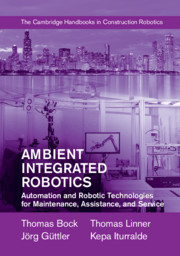 Ambient Integrated Robotics
Ambient Integrated Robotics Published online by Cambridge University Press: 09 July 2019
In this chapter, a possible outlook into the future is provided. Considering the newest technology on the market in the young research field of AAL (see Chapter 4), and the youngest research projects (see Chapter 5), new possibilities will exist in the future design of buildings. Buildings mainly consist of four walls and a ceiling, with water and electrical supply. However, with increasing demand for assistive technologies, and with an increasing technology readiness level (TRL) [187] for assistive technologies, there will be a time when this new technology approach will fuse with future building design and construction.
To save this book to your Kindle, first ensure no-reply@cambridge.org is added to your Approved Personal Document E-mail List under your Personal Document Settings on the Manage Your Content and Devices page of your Amazon account. Then enter the ‘name’ part of your Kindle email address below. Find out more about saving to your Kindle.
Note you can select to save to either the @free.kindle.com or @kindle.com variations. ‘@free.kindle.com’ emails are free but can only be saved to your device when it is connected to wi-fi. ‘@kindle.com’ emails can be delivered even when you are not connected to wi-fi, but note that service fees apply.
Find out more about the Kindle Personal Document Service.
To save content items to your account, please confirm that you agree to abide by our usage policies. If this is the first time you use this feature, you will be asked to authorise Cambridge Core to connect with your account. Find out more about saving content to Dropbox.
To save content items to your account, please confirm that you agree to abide by our usage policies. If this is the first time you use this feature, you will be asked to authorise Cambridge Core to connect with your account. Find out more about saving content to Google Drive.